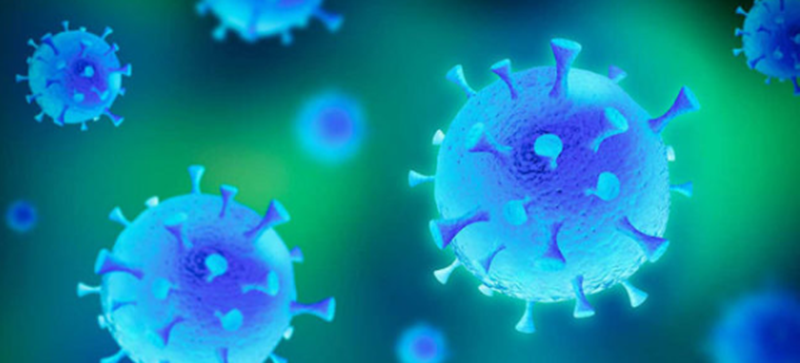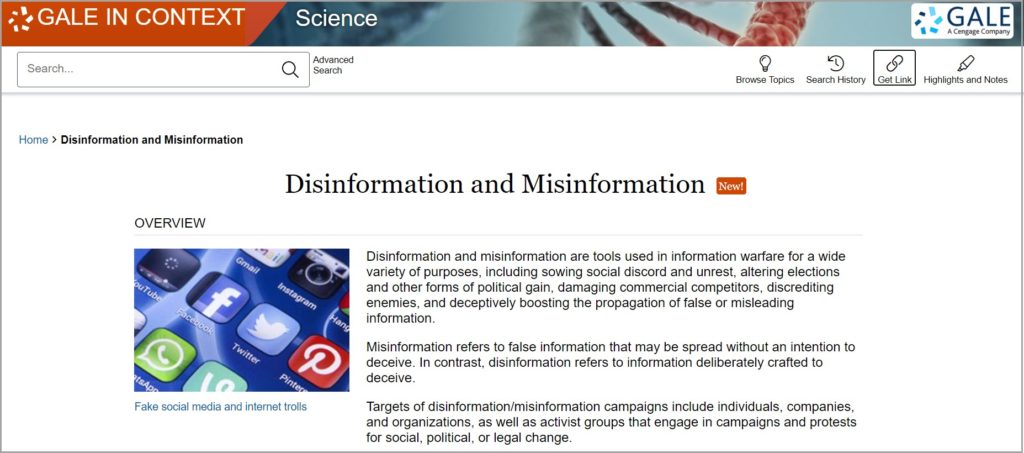| By K. Lee Lerner |
Misinformation and disinformation plague coverage of many news events, and the COVID-19 global pandemic has proven no exception. With regard to the spread of errant and misleading information—ranging from the origins of the SARS-CoV-2 virus to subsequent efforts by public health officials to slow the spread of COVID-19—both media and medical experts have characterized the outbreak as a corresponding “infodemic.”
Now, perhaps more than ever, it’s essential for learners to have an understanding of misinformation and disinformation, especially how they relate to issues that affect their lives. That’s why Gale released a new disinformation and misinformation topic page in Gale In Context: Science. This topic page serves as a hub for users to explore many topics, including the “infodemic” related to COVID-19.
The Role of Technology
The media landscape has changed dramatically over the last decade. In America and Europe, people increasingly rely on social media for news, and distrust of traditional media is at an all-time high. In many countries, including the United States, political polarization has driven people into information silos where they select news sources not for their accuracy, but rather on the assurance that news will be selected and spun to reflect their own ideology. The technologies that enable greater communication between people have also proven capable of fractionating populations into isolated information pockets where data and scientific expertise are discounted or dismissed in favor of closely held political or religious beliefs.
Vaccine Development and Availability
Now, more than nine months after the World Health Organization (WHO)’s formal declaration of a pandemic, the continuing fight against misinformation and disinformation enters a new stage. Public health experts warn that the development and distribution of a vaccine provides new opportunities for the dissemination of misinformation, which is the unintentional sharing of erroneous information, and disinformation, which is the deliberate creation or alteration of information with an intent to manipulate or deceive.
With unprecedented speed, scientists have developed an array of promising vaccines. At the time of this writing, two mRNA-based vaccines have been approved for emergency use by an expert review panel of the U.S. Food and Drug Administration (FDA). Other vaccines are in advanced clinical testing based on promising preliminary results.
Russia and China approved vaccines for at least limited distribution months ago, but many experts outside those countries question whether those vaccine approvals were based on the same extensive and rigorous large-scale clinical trials demanded elsewhere. In the United States, for example, the FDA requires that candidate vaccines, even those seeking emergency use authorizations, must be proven safe and effective based on large-scale, double-blind clinical trials where neither the person administering a test injection nor the recipient receiving it knows if the injection contains a candidate vaccine or a placebo.
While legitimate questions remain about the length of protection the vaccines offer and the distribution plans, vaccines evaluated thus far have greatly exceeded minimum safety and effectiveness standards.
Thinking Forward
While vaccines provide individual protection against specific diseases like COVID-19, those who acquire immunity via vaccination also contribute to herd immunity and the protection of those still vulnerable in their community.
Accordingly, misinformation and disinformation related to the emerging array of vaccines can contribute to what public health experts term “vaccine hesitancy,” the refusal or delay in accepting vaccines despite abundant scientific evidence of their effectiveness and safety. Multiple studies have demonstrated that vaccine hesitancy is increased by unfounded fears driven by errant information, a general lack of familiarity with the science related to vaccine development, and complacency that the vaccination of others is sufficient protection.
Herd immunity can only occur when a sufficient proportion of a population has immunity acquired naturally by prior exposure to a disease or via vaccination. Falsehoods that decrease public confidence in vaccines also decrease the chance that vaccines can create the herd immunity necessary to fully control a disease outbreak. Instead of being eradicated or brought under control, disease can become endemic within a population or region, with dire health and economic consequences.
For this reason, public health officials consistently urge people to rely on medical experts and peer-reviewed science in making decisions about whether a vaccine is safe and effective.
The Strength of Science
Of course, experts can be wrong, and science does evolve. That is a great strength of science, not a weakness. Essential elements of the scientific process include the willingness to alter conclusions in the face of new data, to reject what is disproven, and to adopt the best-supported explanations. For those who are well acquainted with the scientific method, changes in recommendations regarding mask use, quarantine times, and treatments are the natural result of a learning curve related to dealing with a novel virus.
For the latest news and journal articles on COVID-19 vaccines, visit Gale’s updated vaccine topic page in Gale In Context: Science or the vaccination topic page in Gale Health and Wellness.
References:
Centers for Disease Control and Prevention (CDC). “Coronavirus (COVID-19).” https://www.cdc.gov/coronavirus/2019-ncov/index.html (accessed December 16, 2020).
Lerner, K. Lee, and Brenda Wilmoth Lerner. “Novel coronavirus outbreak (COVID-19).” In Gale Science Online Collection. Detroit, MI: Gale, 2020. Gale In Context: Science (accessed December 16, 2020). https://link.gale.com/apps/portal/DPZIKK575641375/HWRC?u=gale&sid=HWRC&xid=f0d95b88
Morens, David M., Anthony S. Fauci. “Emerging Pandemic Diseases: How We Got to COVID-19.” Cell. https://www.cell.com/cell/fulltext/S0092-8674(20)31012-6# (accessed December 16, 2020).
Johns Hopkins Bloomberg School of Public Health. “What is Herd Immunity and How Can We Achieve It With COVID-19.” https://www.jhsph.edu/covid-19/articles/achieving-herd-immunity-with-covid19.html (accessed December 16, 2020).
The New York Times. “Coronavirus Vaccine Tracker.” https://www.nytimes.com/interactive/2020/science/coronavirus-vaccine-tracker.html (accessed December 16, 2020).
U.S. Food and Drug Administration (FDA). “Coronavirus Disease 2019 (COVID-19).” https://www.fda.gov/emergency-preparedness-and-response/counterterrorism-and-emerging-threats/coronavirus-disease-2019-covid-19 (accessed December 16, 2020).
Zarocostas, J. “How to fight an infodemic.” The Lancet. 395. (2020): 676.
Meet the Author
K. Lee Lerner is a writer, editor, and aviator who, along with Brenda Wilmoth Lerner, is the editor of the Gale Encyclopedia of Espionage, Intelligence, and Security; Climate Change: In Context; and many other award-winning books and articles on science, technology, and a range of global issues. He also serves as the scientific advisor for Gale In Context: Science. A full bio and list of his work may be found at scholar.harvard.edu/kleelerner and harvard.academia.edu/KLeeLerner/.
The views and information expressed by Lerner in this blog are his own.


